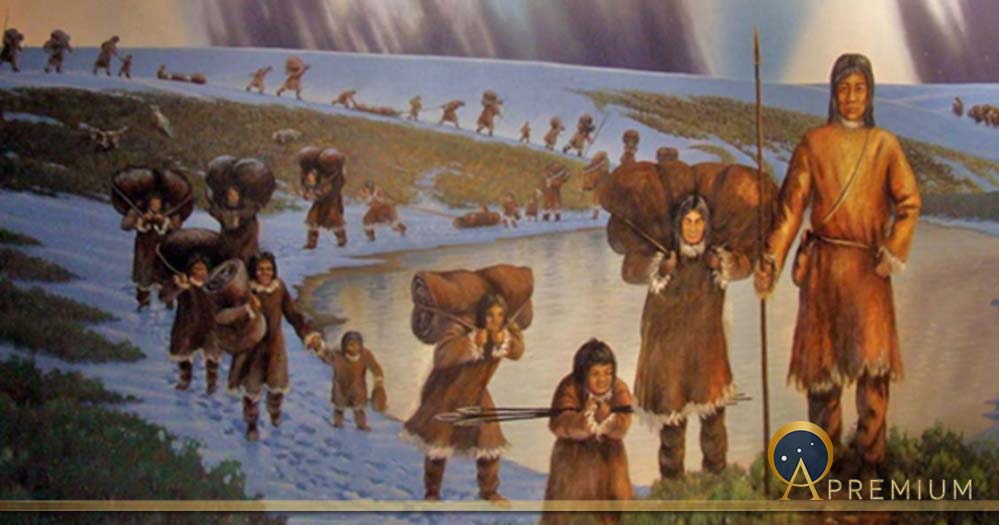The Chumash: The Seashell First People Of North America
The question of how people first came to North America is as complicated as when they arrived. With new evidence comes new theories and the dates are being revised constantly. While the colonization of the Americas remains a highly debated topic, the truth is that the exact timing of the first arrivals remains unknown. The crossing of the Bering Land Bridge has been the longstanding theory simply because that has always been considered the simplest connection between Asia and North America. It is the only place where people could walk from one side to the other when sea levels dropped and ice formed across the land. It is possible, and more than likely, that people also arrived from elsewhere.

Genetic settlement of Beringia. The initial peopling of Beringia (the region depicted in light yellow) was followed by a standstill after which the ancestors of the Native Americans spread swiftly all over the New World while some of the Beringian maternal lineages (C1a) spread westwards.(CC BY-SA 2.5)
Earlier theories proposed that the first people arrived on the American continent as one large group who braved their way across a frozen and desolate land bridge. Later studies indicate that separate groups, speaking foreign languages, arrived at different times from different directions and brought their own experiences. It is a complex story including many people, with many interesting backgrounds.
Crossing the Bering Land Bridge is possible although not as easy as traveling down the ‘kelp highway’ - a rich kelp forest ecosystems that follows nearly the entire coast and could plausibly have supported seafaring peoples. This theory suggests that the first Americans arrived not by land, but by sea, following the coastline of the Pacific Rim of north-eastern Asia and Beringia as far south as South America. Testing the kelp highway hypothesis is complicated as much of the archaeological evidence would have been submerged by rising seas since the last glacial maximum approximately 26,000 years ago. The most promising sites may still be underwater and covered by layers of deep silt. Either trip would have taken months to move as far south as what is now California and beyond, and they would have faced immense hardships with many dying along the way.
The landscape these ancient people walked into was substantially different to what it is today.
Like this Preview and want to read on? You can! JOIN US THERE ( with easy, instant access ) and see what you’re missing!! All Premium articles are available in full, with immediate access.
For the price of a cup of coffee, you get this and all the other great benefits at Ancient Origins Premium. And - each time you support AO Premium, you support independent thought and writing.

Consider if you have Chumash DNA ancestry. Click here to find out.
Top Image: First Americans, photo of mural in the Page Museum, Los Angeles, by Travis S (CC BY-NC 2.0)
By: Michelle Freson




















Comments
According to the Urantia Book, the paleo-Indians crossed the Bering Strait 85,000 years ago. And, the paleo-Eskimo crossed over from Greenland about 82,500 years ago.
The general problem with these and similar theories on the ancient post-Ice Age people is that it’s NOT PLAUSIBLE that a culture once HAD a capability/technology, be it shipbuilding/seafaring, metal-working, stone masonry, etc., and then later abandoning that capability or technology and having it completely disappear from that culture, with no trace of that knowledge present when the Europeans or others arrived. For that to have happened, there would probably have a be something akin to having the culture ‘bombed back to the stone age’ as they say. But as far as we know, only one people seem to have been 'bombed back to the stone age' – the fair-haired Atlanteans, circa 115k BC, adding the zero back to Plato’s timeline – the event that caused the sudden emergence of the Ice Age.
Nobody gets paid to tell the truth.
Yep. not to mention the countless tales of a mysterious land to the west in Europe and the Western African region. And of course we have the Aztec’ Atzlan vs Plato’s Atlantis. if the Mid Atlatnic ridge was exposed, as it likely was at the same time, it would have been a great jumping off point.
The peopling of the americas is not a open and shut case, pre clovis and pre pre clovis is evident, the technology expressed in meso america and south america are much more advanced than in the northern latitudes. the story is not well understood. 30K artifacts in a Mexican cave speak to this false narritive. Additionally, in the amazon, the folks are related to native Australians and Melanesians. the story is not complete, we will fill in the missing pieces as we go, the beringia narritive is valid, one of the many waves of folks peopling the americas, however the folks from beringia is probably the last wave rather than the first wave, i think the earliest people came by boat, kayak and sailed the coasts and rivers. Most archaeological sites are underwater from the rise in sea levels, it is a story which will add many more chapters until it is written, it is only a matter of time before we find denisovian and neandrithal remains in the americas. sorry for the mis spells, no spell check on this.